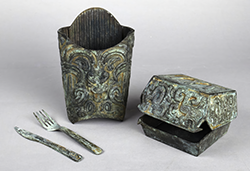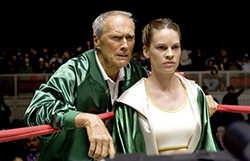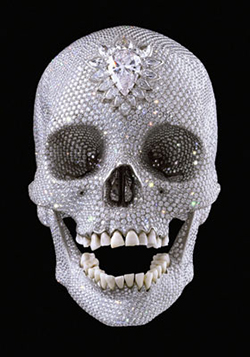MENU
The Electronic Scholarly Publishing Project: Providing access to classic scientific papers and other scholarly materials, since 1993. More About: ESP | OUR CONTENT | THIS WEBSITE | WHAT'S NEW | WHAT'S HOT
Comparative Timelines
The ESP Timeline (one of the site's most popular features) has been completely updated to allow the user to select (using the timeline controls above each column) different topics for the left and right sides of the display.
Select:
New Left Column
New Left Column
Dates
Decade
New Right Column
New Right Column
 Gladiator wins Academy Award for best picture. When the Ridley Scott-directed epic opened in May, audiences loved it, but few predicted it would be a best picture winner. But as the months wore on, Academy members clearly maintained their admiration for the film, the kind of intelligent spectacle that Hollywood does best.
Gladiator wins Academy Award for best picture. When the Ridley Scott-directed epic opened in May, audiences loved it, but few predicted it would be a best picture winner. But as the months wore on, Academy members clearly maintained their admiration for the film, the kind of intelligent spectacle that Hollywood does best.
2000
(no entry for this year)
 A Beautiful Mind wins Academy Award for best picture. It doesn t sound like a surefire project: A biopic about a delusional math genius. But Russell Crowe turned in another great performance, and Oscars went to director Ron Howard, supporting actress Jennifer Connelly, and writer Akiva Goldsman, adapting Sylvia Nasar's book about John Nash.
A Beautiful Mind wins Academy Award for best picture. It doesn t sound like a surefire project: A biopic about a delusional math genius. But Russell Crowe turned in another great performance, and Oscars went to director Ron Howard, supporting actress Jennifer Connelly, and writer Akiva Goldsman, adapting Sylvia Nasar's book about John Nash.
2001
(no entry for this year)
 Sculpture by Zhang Hongtu: Mai Dang Lao (McDonald's), a set of readily identifiable McDonald's hamburger box, french-fry container, fork, and knife are cast in bronze and adorned with traditional Chinese designs. The artist has transformed ubiquitous consumer items into what at first glance appear to be Shang dynasty artifacts. Hilarious.
Sculpture by Zhang Hongtu: Mai Dang Lao (McDonald's), a set of readily identifiable McDonald's hamburger box, french-fry container, fork, and knife are cast in bronze and adorned with traditional Chinese designs. The artist has transformed ubiquitous consumer items into what at first glance appear to be Shang dynasty artifacts. Hilarious.
 Chicago wins Academy Award for best picture. Hollywood had circled around a movie adaptation of the stage musical since the 1970s, but director Rob Marshall and writer Bill Condon figured out how to make it work. They delivered a razzle-dazzle musical with wry observations about contemporary obsessions with scandal and celebrity.
Chicago wins Academy Award for best picture. Hollywood had circled around a movie adaptation of the stage musical since the 1970s, but director Rob Marshall and writer Bill Condon figured out how to make it work. They delivered a razzle-dazzle musical with wry observations about contemporary obsessions with scandal and celebrity.
2002
 Sculpture by Zhang Hongtu: Mai Dang Lao (McDonald's), a set of readily identifiable McDonald's hamburger box, french-fry container, fork, and knife are cast in bronze and adorned with traditional Chinese designs. The artist has transformed ubiquitous consumer items into what at first glance appear to be Shang dynasty artifacts. Hilarious.
Sculpture by Zhang Hongtu: Mai Dang Lao (McDonald's), a set of readily identifiable McDonald's hamburger box, french-fry container, fork, and knife are cast in bronze and adorned with traditional Chinese designs. The artist has transformed ubiquitous consumer items into what at first glance appear to be Shang dynasty artifacts. Hilarious.
 The Lord of the Rings: The Return of the King wins Academy Award for best picture. Peter Jackson's film trilogy, adapted from the J.R.R. Tolkien novels, earned billions at the B.O., the intense loyalty of fans, and industry admiration for the new technology introduced in the fantasy epic. It also became the third film to win 11 Oscars, after Ben-Hur and Titanic and LOTR became the only one to sweep all its categories.
The Lord of the Rings: The Return of the King wins Academy Award for best picture. Peter Jackson's film trilogy, adapted from the J.R.R. Tolkien novels, earned billions at the B.O., the intense loyalty of fans, and industry admiration for the new technology introduced in the fantasy epic. It also became the third film to win 11 Oscars, after Ben-Hur and Titanic and LOTR became the only one to sweep all its categories.
2003
(no entry for this year)
 Million Dollar Baby wins Academy Award for best picture. This was Clint Eastwood's second big night at the Academy Awards, following Unforgiven. The tale of a woman boxer holds another distinction: In Oscar's 77th ceremony, this became the first best picture winner set in Southern California.
Million Dollar Baby wins Academy Award for best picture. This was Clint Eastwood's second big night at the Academy Awards, following Unforgiven. The tale of a woman boxer holds another distinction: In Oscar's 77th ceremony, this became the first best picture winner set in Southern California.
2004
(no entry for this year)
 Crash wins Academy Award for best picture. In the build-up to the Oscars, the gay western Brokeback Mountain had dominated the awards scene. But the Paul Haggis-directed Crash came out the big winner.
Crash wins Academy Award for best picture. In the build-up to the Oscars, the gay western Brokeback Mountain had dominated the awards scene. But the Paul Haggis-directed Crash came out the big winner.
2005
(no entry for this year)
 The Departed wins Academy Award for best picture. After five nominations as director, Martin Scorsese hit the jackpot with No. 6, winning one of the film's four awards. It's an Oscar rarity since it's a remake, based on the 2002 Hong Kong crime thriller Infernal Affairs.
The Departed wins Academy Award for best picture. After five nominations as director, Martin Scorsese hit the jackpot with No. 6, winning one of the film's four awards. It's an Oscar rarity since it's a remake, based on the 2002 Hong Kong crime thriller Infernal Affairs.
2006
(no entry for this year)
 Sculpture by Damien Hirst: For the Love of God consists of a platinum cast of an 18th-century human skull encrusted with 8,601 flawless diamonds, including a pear-shaped pink diamond located in the forehead that is known as the Skull Star Diamond. The skull's teeth are actual human teeth, and were purchased by Hirst in London. The artwork is a Memento mori, or reminder of the mortality of the viewer. In 2007, art historian Rudi Fuchs, observed: 'The skull is out of this world, celestial almost. It proclaims victory over decay. At the same time it represents death as something infinitely more relentless. Compared to the tearful sadness of a vanitas scene, the diamond skull is glory itself.' Costing 14 million to produce, the work was placed on its inaugural display at the White Cube gallery in London in an exhibition Beyond belief with an asking price of 50 million. This would have been the highest price ever paid for a single work by a living artist. The base for the work is a human skull bought in a shop in Islington. It is thought to be that of a 35-year-old European who lived between 1720 and 1810. The work's title was supposedly inspired by Hirst's mother, who once asked, "For the love of God, what are you going to do next? Hirst said that the work was sold on 30 August 2007, for 50 million, to an anonymous consortium. Christina Ruiz, editor of The Art Newspaper, claims that Hirst had failed to find a buyer and had been trying to offload the skull for 38 million. Immediately after these allegations were made, Hirst claimed he had sold it for the full asking price, in cash, leaving no paper trail. The consortium that bought the piece included Hirst himself.
Sculpture by Damien Hirst: For the Love of God consists of a platinum cast of an 18th-century human skull encrusted with 8,601 flawless diamonds, including a pear-shaped pink diamond located in the forehead that is known as the Skull Star Diamond. The skull's teeth are actual human teeth, and were purchased by Hirst in London. The artwork is a Memento mori, or reminder of the mortality of the viewer. In 2007, art historian Rudi Fuchs, observed: 'The skull is out of this world, celestial almost. It proclaims victory over decay. At the same time it represents death as something infinitely more relentless. Compared to the tearful sadness of a vanitas scene, the diamond skull is glory itself.' Costing 14 million to produce, the work was placed on its inaugural display at the White Cube gallery in London in an exhibition Beyond belief with an asking price of 50 million. This would have been the highest price ever paid for a single work by a living artist. The base for the work is a human skull bought in a shop in Islington. It is thought to be that of a 35-year-old European who lived between 1720 and 1810. The work's title was supposedly inspired by Hirst's mother, who once asked, "For the love of God, what are you going to do next? Hirst said that the work was sold on 30 August 2007, for 50 million, to an anonymous consortium. Christina Ruiz, editor of The Art Newspaper, claims that Hirst had failed to find a buyer and had been trying to offload the skull for 38 million. Immediately after these allegations were made, Hirst claimed he had sold it for the full asking price, in cash, leaving no paper trail. The consortium that bought the piece included Hirst himself.
 No Country for Old Men wins Academy Award for best picture. The film, based on Cormac McCarthy's novel, became the second consecutive bloody actioner to take the big prize. And it was the second winner in Oscar history directed by a duo: Joel and Ethan Coen (after the team from West Side Story ).
No Country for Old Men wins Academy Award for best picture. The film, based on Cormac McCarthy's novel, became the second consecutive bloody actioner to take the big prize. And it was the second winner in Oscar history directed by a duo: Joel and Ethan Coen (after the team from West Side Story ).
2007
 Sculpture by Damien Hirst: For the Love of God consists of a platinum cast of an 18th-century human skull encrusted with 8,601 flawless diamonds, including a pear-shaped pink diamond located in the forehead that is known as the Skull Star Diamond. The skull's teeth are actual human teeth, and were purchased by Hirst in London. The artwork is a Memento mori, or reminder of the mortality of the viewer. In 2007, art historian Rudi Fuchs, observed: 'The skull is out of this world, celestial almost. It proclaims victory over decay. At the same time it represents death as something infinitely more relentless. Compared to the tearful sadness of a vanitas scene, the diamond skull is glory itself.' Costing 14 million to produce, the work was placed on its inaugural display at the White Cube gallery in London in an exhibition Beyond belief with an asking price of 50 million. This would have been the highest price ever paid for a single work by a living artist. The base for the work is a human skull bought in a shop in Islington. It is thought to be that of a 35-year-old European who lived between 1720 and 1810. The work's title was supposedly inspired by Hirst's mother, who once asked, "For the love of God, what are you going to do next? Hirst said that the work was sold on 30 August 2007, for 50 million, to an anonymous consortium. Christina Ruiz, editor of The Art Newspaper, claims that Hirst had failed to find a buyer and had been trying to offload the skull for 38 million. Immediately after these allegations were made, Hirst claimed he had sold it for the full asking price, in cash, leaving no paper trail. The consortium that bought the piece included Hirst himself.
Sculpture by Damien Hirst: For the Love of God consists of a platinum cast of an 18th-century human skull encrusted with 8,601 flawless diamonds, including a pear-shaped pink diamond located in the forehead that is known as the Skull Star Diamond. The skull's teeth are actual human teeth, and were purchased by Hirst in London. The artwork is a Memento mori, or reminder of the mortality of the viewer. In 2007, art historian Rudi Fuchs, observed: 'The skull is out of this world, celestial almost. It proclaims victory over decay. At the same time it represents death as something infinitely more relentless. Compared to the tearful sadness of a vanitas scene, the diamond skull is glory itself.' Costing 14 million to produce, the work was placed on its inaugural display at the White Cube gallery in London in an exhibition Beyond belief with an asking price of 50 million. This would have been the highest price ever paid for a single work by a living artist. The base for the work is a human skull bought in a shop in Islington. It is thought to be that of a 35-year-old European who lived between 1720 and 1810. The work's title was supposedly inspired by Hirst's mother, who once asked, "For the love of God, what are you going to do next? Hirst said that the work was sold on 30 August 2007, for 50 million, to an anonymous consortium. Christina Ruiz, editor of The Art Newspaper, claims that Hirst had failed to find a buyer and had been trying to offload the skull for 38 million. Immediately after these allegations were made, Hirst claimed he had sold it for the full asking price, in cash, leaving no paper trail. The consortium that bought the piece included Hirst himself.
 Slumdog Millionaire wins Academy Award for best picture. No foreign-language film has won best picture, but Slumdog Millionaire comes closest, since one-third of the dialogue is in Hindi. It's also a rarity, since it centers around a TV show: India's version of Who Wants to Be a Millionaire.
Slumdog Millionaire wins Academy Award for best picture. No foreign-language film has won best picture, but Slumdog Millionaire comes closest, since one-third of the dialogue is in Hindi. It's also a rarity, since it centers around a TV show: India's version of Who Wants to Be a Millionaire.
2008
(no entry for this year)
 The Hurt Locker wins Academy Award for best picture. The film, directed by Kathryn Bigelow and written by Mark Boal, beat out some tough competition, including the record-breaking Avatar Hurt Locker earned $49 million at the global box office, the lowest-grossing film in Oscar history. But it has gained many fans and admirers over the years, and Bigelow so far is the only woman to win a directing Oscar.
The Hurt Locker wins Academy Award for best picture. The film, directed by Kathryn Bigelow and written by Mark Boal, beat out some tough competition, including the record-breaking Avatar Hurt Locker earned $49 million at the global box office, the lowest-grossing film in Oscar history. But it has gained many fans and admirers over the years, and Bigelow so far is the only woman to win a directing Oscar.
2009
(no entry for this year)
ESP Quick Facts
ESP Origins
In the early 1990's, Robert Robbins was a faculty member at Johns Hopkins, where he directed the informatics core of GDB — the human gene-mapping database of the international human genome project. To share papers with colleagues around the world, he set up a small paper-sharing section on his personal web page. This small project evolved into The Electronic Scholarly Publishing Project.
ESP Support
In 1995, Robbins became the VP/IT of the Fred Hutchinson Cancer Research Center in Seattle, WA. Soon after arriving in Seattle, Robbins secured funding, through the ELSI component of the US Human Genome Project, to create the original ESP.ORG web site, with the formal goal of providing free, world-wide access to the literature of classical genetics.
ESP Rationale
Although the methods of molecular biology can seem almost magical to the uninitiated, the original techniques of classical genetics are readily appreciated by one and all: cross individuals that differ in some inherited trait, collect all of the progeny, score their attributes, and propose mechanisms to explain the patterns of inheritance observed.
ESP Goal
In reading the early works of classical genetics, one is drawn, almost inexorably, into ever more complex models, until molecular explanations begin to seem both necessary and natural. At that point, the tools for understanding genome research are at hand. Assisting readers reach this point was the original goal of The Electronic Scholarly Publishing Project.
ESP Usage
Usage of the site grew rapidly and has remained high. Faculty began to use the site for their assigned readings. Other on-line publishers, ranging from The New York Times to Nature referenced ESP materials in their own publications. Nobel laureates (e.g., Joshua Lederberg) regularly used the site and even wrote to suggest changes and improvements.
ESP Content
When the site began, no journals were making their early content available in digital format. As a result, ESP was obliged to digitize classic literature before it could be made available. For many important papers — such as Mendel's original paper or the first genetic map — ESP had to produce entirely new typeset versions of the works, if they were to be available in a high-quality format.
ESP Help
Early support from the DOE component of the Human Genome Project was critically important for getting the ESP project on a firm foundation. Since that funding ended (nearly 20 years ago), the project has been operated as a purely volunteer effort. Anyone wishing to assist in these efforts should send an email to Robbins.
ESP Plans
With the development of methods for adding typeset side notes to PDF files, the ESP project now plans to add annotated versions of some classical papers to its holdings. We also plan to add new reference and pedagogical material. We have already started providing regularly updated, comprehensive bibliographies to the ESP.ORG site.
ESP Picks from Around the Web (updated 06 MAR 2017 )
Old Science

Weird Science

Treating Disease with Fecal Transplantation
Fossils of miniature humans (hobbits) discovered in Indonesia

Dinosaur tail, complete with feathers, found preserved in amber.
Astronomy

Mysterious fast radio burst (FRB) detected in the distant universe.